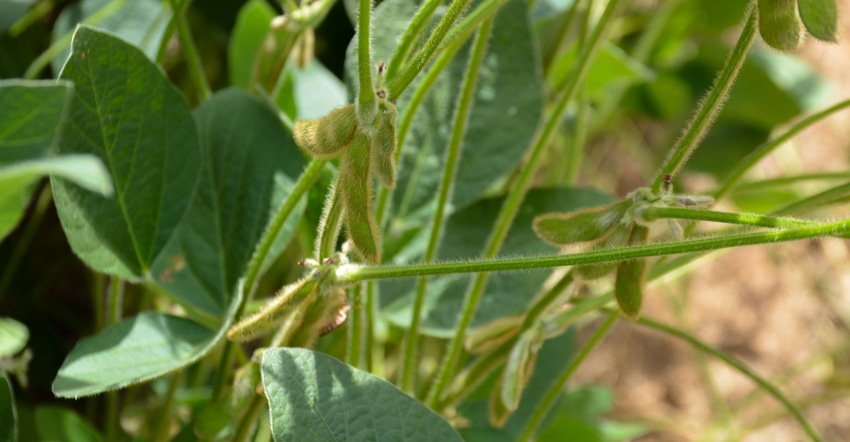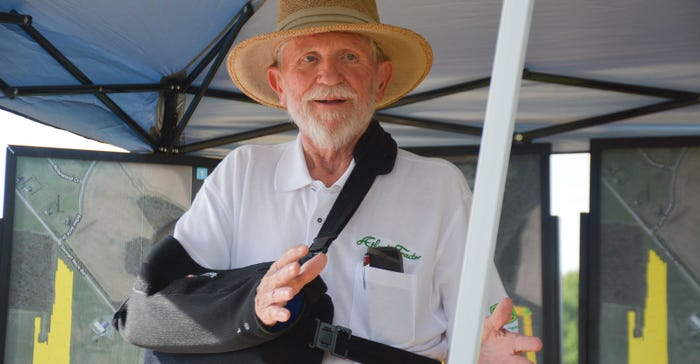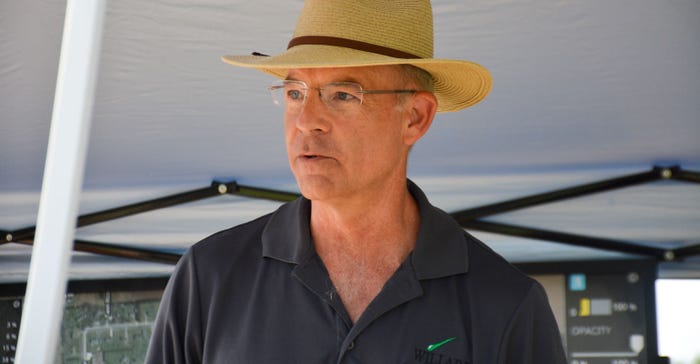
Development pressure will always hamper agriculture’s growth in the mid-Atlantic, especially on Delmarva. That’s one reason Lyle Jarrett is tinkering with soybeans on a plot at the University of Maryland’s Eastern Shore research farm: to get more from less.
“The progressive growers are looking at anything they can do to take and increase their yields, and we have to,” Jarrett says. “We’re losing farmland; population’s growing. We got to take and produce more per acre. The technology is here. Good hybrids are here, and we can do it.”
Jarrett, an agronomist for Atlantic Tractor and owner of Environmental Agronomics, an agricultural consulting firm, has a goal of getting 80 to 90 bushels per acre on his UMES plots. He’s using different combinations of planting populations, in-furrow treatments and post-flowering applications to get there.
“I call it demonstration plots. My goal is to see if we can take and get comparable yields with lower plant pops and increase those yields by the Strong Finish program or by in-furrow fertilization," he says. “Just looking at those different situations and then determining whether the return on investment is to the point where it's worth doing that type of thing.”
Making adjustments
Two years ago, the fields Jarrett’s using averaged about 51 bushels per acre. Even though the land used to be home to a Perdue Farms hatchery, no manure was ever applied on the land, he says, so fertilizer was needed.
He developed a dry fertilizer program comprised of potash, sulfur, zinc and 25 pounds of phosphorus.
Planting date this past spring was supposed to be April 20. Jarrett was going to plant Plenish soybeans with maturity group numbers of 4.6 and 4.8, some treated and some not. The treated seeds had two different fungicides and a rhizobium inoculant.
But Mother Nature, just like on most farms, dictated a later planting date: May 11.

Lyle Jarrett says less farmland and an increasing population are forcing growers to do more with less. He’s tinkering with plant populations and planting dates to find out the best combination for Eastern Shore growers.
The soybeans were planted in either 15-inch or 30-inch rows with in-furrow fertilization using a blend from AgroLiquid.
Jarrett started with plant populations of 144,000 seeds per acre, then dropped populations in some plots to 120,000 seeds, then 110,000 seeds.
“I wanted to see and compare going down in population if we can still maintain the yield and the return on investment,” he says. “So, that’s another trial we have going on here.”
Good pod sets came out of both the 15- and 30-inch trials, likely the result of great moisture in the area this summer. If he had to do one thing over again, though, Jarrett says that he would have planted the 4.6 soybeans in the 30-inch plots because they “bushel a little more” than the 4.8 beans.
A post application was done June 15 that included Roundup and a post grass herbicide with an adjuvant. He pulled tissues samples from nine locations in the plots at third trifoliate.
At R1 growth stage — at the beginning of July — Jarrett pulled more samples. “Everything looked good. There was plenty of potash, nitrogen,” he says. “Nodulation was great. They were pink as they could be grabbing N from the atmosphere.”
Finishing the crop
For most growers, finishing soybeans involves a final dose of fungicide in August to take the crop over the finish line.
Jarrett worked with Willard Agri-Service to test out the company’s Strong Finish package, a combination of fungicide, an insecticide, a biological nutrient enhancer and a legume enhancer.
Mike Twining, vice president of sales and marketing for Willard Agri-Service, says the company decided five years ago that it was going to refocus its efforts on understanding soybeans and how to manage them.
“One of the things we’re trying to do is promote the concept of a finisher, so whether it’s corn or beans,” he says. “If you take corn, 30% to 40% of nutrient uptake is occurring post tassel, so how you finish is more important than ever. And soybeans, if they don’t start doing stuff until bloom and we’re not in our fields looking or doing anything, you’re missing a huge opportunity because most of yield is determined after bloom.”

Mike Twining, vice president of sales and marketing for Willard Agri-Service, says growers should focus on things to enhance soybeans post tassel, when 30% to 40% of nutrient uptake occurs.
The package — Miravis Top fungicide, Warrior II insecticide, Biogrowth NE nutrient enhancer and Foliomate for legumes — was applied right after the beans reached R2, about July 12. A plot with no application was done for comparison.
It remains to be seen what the effects on overall yield will be, but Twining says that across 39 “partnership plots” across Delmarva, the use of Strong Finish raised full-season yields by an average of 8.1 bushels per acre and double-crop yields by an average 7.6 bushels per acre.
“This program, if you did all the components … is maybe about $35 an acre. Even at $10 beans … you can take the wife on a nice trip after that if you get that kind of response,” he says.
The sooner beans are planted, the better. Twining says the company has collected data from 120,000 acres across Delmarva and the mid-Atlantic since 1996 through its High-Q decision support system. Soybean growth is reliant on day length, he says, and data collected from High-Q reinforces that soybeans should be in the ground earlier and blooming by June 21.
“The later you plant, the lower you yield,” Twining says. “If you’re going after high-yielding beans, at least according to the data, it’s planting date and the earlier you get it in.”
Early planting is risky, and replanting is necessary if early spring is too cold or wet. Still, Jarrett says that he’s seeing more growers go with earlier-planted soybeans.
“When you have the corn planter in the field, or you have any other planter in the field, you should be planting beans at the same time,” he says.
For more information, visit willardag.com.
About the Author(s)
You May Also Like






